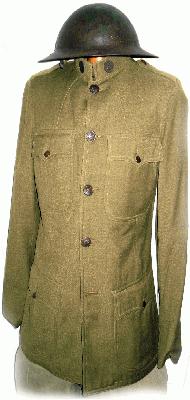U.S. Army Uniforms of World War One

Six months after the United States entered the First World War all sorts of issues had to be addressed, such as the matter of the Sam Brown belt. Since 1914 the famous sword belt had been established as an emblem of authority among all the Allied armies along the assorted fronts, but the Americans didn't like it one bit. The level-headed editors of Collier's Magazine published the attached editorial pointing out that such matters of military fashion simply don't matter at a time of national emergency and to illustrate their point they quoted a portion from Under Fire by Henri Barbusse which laid plain how miserable everyone (without exception) looks in the trenches, regardless of their accessories.
This U.S. Army uniform regulation announced in the September 13th, 1918 issue of THE STARS and STRIPES helped to put British, French (and later German) tailors to work on the uniforms of U.S. officers:
"According to this plan, each Quartermaster depot will have a tailoring system through which the officer can buy his cloth and then be fitted and outfitted on the spot. At each depot, civilian labor will be contracted and the officer need pay for only his share of the labor cost."
"It has officially been decided that the A.E.F. has grown up and must now wear pants."
A 1919 order appeared in THE STARS and STRIPES indicating that the era of army-issued olive drab knee breeches had passed and soon all American Army personnel would be issued long pants: "Experts have decided that the breeches legs shrink when wet and impede the circulation, and it is assured that the kind that he used to wear in civilian life will not cause the Doughboy cold feet..."
"To supply the A.E.F. until August, 2,500,000 pairs of pants have been ordered, and these, which will cost only nineteen cents a leg more than breeches did, will be of better quality than the latter." In an attempt to save money, the U.S. Army issued an order that N.C.O.s were to wear chevrons on one arm only. This uniform regulation was printed for all home bound Doughboys to see early in 1919; the order was later rescinded, however, it seemed that the General who was placed in charge of all state-side Army units during World War One disliked the European style military fashions that the A.E.F. was affecting. He also wished to ban the trench coat, over-seas cap, puttees and the Sam Brown Belt. |
MORE ARTICLES >>> PAGE: * 1 * 2 * 3 * 4 * 5 * 6 * 7 * |
|